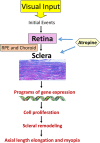Biological Mechanisms of Atropine Control of Myopia
- PMID: 31899695
- PMCID: PMC7176345
- DOI: 10.1097/ICL.0000000000000677
Biological Mechanisms of Atropine Control of Myopia
Abstract
Myopia is a global problem that is increasing at an epidemic rate in the world. Although the refractive error can be corrected easily, myopes, particularly those with high myopia, are susceptible to potentially blinding eye diseases later in life. Despite a plethora of myopia research, the molecular/cellular mechanisms underlying the development of myopia are not well understood, preventing the search for the most effective pharmacological control. Consequently, several approaches to slowing down myopia progression in the actively growing eyes of children have been underway. So far, atropine, an anticholinergic blocking agent, has been most effective and is used by clinicians in off-label ways for myopia control. Although the exact mechanisms of its action remain elusive and debatable, atropine encompasses a complex interplay with receptors on different ocular tissues at multiple levels and, hence, can be categorized as a shotgun approach to myopia treatment. This review will provide a brief overview of the biological mechanisms implicated in mediating the effects of atropine in myopia control.
Conflict of interest statement
R. W. Beuerman received honoraria from Santen Pharmaceutical Co., Ltd, and is a cofounder and chief scientific officer at SinSaLabs. The remaining author has no funding or conflicts of interest to disclose.
Figures

References
-
- Bourne RR, Stevens GA, White RA, et al. Causes of vision loss worldwide, 1990-2010: A systematic analysis. Lancet Glob Health 2013;1:e339–e349. - PubMed
-
- Holden BA, Fricke TR, Wilson DA, et al. Global prevalence of myopia and high myopia and temporal trends from 2000 through 2050. Ophthalmology 2016;123:1036–1042. - PubMed
-
- Wang TJ, Chiang TH, Wang TH, et al. Changes of the ocular refraction among freshmen in National Taiwan University between 1988 and 2005. Eye 2009;23:1168–1169. - PubMed
-
- Lin LKL, Shih YFF, Hsiao CK, et al. Epidemiologic study of the prevalence and severity of myopia among schoolchildren in Taiwan in 2000. J Formos Med Assoc 2001;100:684–691. - PubMed
-
- Saw SM, Zhang MZ, Hong RZ, et al. Near-work activity, night-lights, and myopia in the Singapore-China study. Evidence-Based Eye Care 2002;3:198–199. - PubMed
Publication types
MeSH terms
Substances
LinkOut - more resources
Full Text Sources
Other Literature Sources

